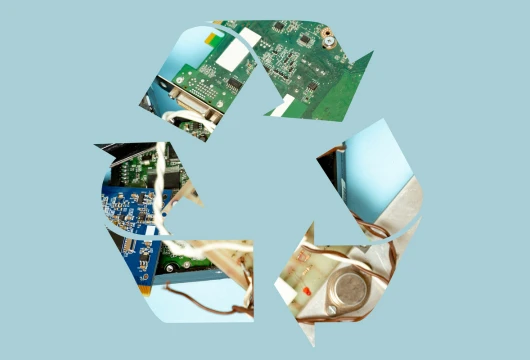E-Waste Recycling
In today’s digital age, electronic devices have become integral to our daily lives, from smartphones and laptops to household appliances and entertainment gadgets. However, with the rapid pace of technological advancement comes a significant environmental challenge: electronic waste, or e-waste. Did you know that [insert specific statistic on e-waste generation, such as ‘over 50 million metric tons of e-waste are generated globally each year ‘]? Unfortunately, due to its toxic components and improper disposal methods, e-waste seriously threatens the environment and human health. Let’s explore seven actionable ways to boost e-waste recycling and understand its importance in building a sustainable future.
1. Raise Awareness and Educate the Public
One of the most effective ways to boost e-waste recycling is to raise awareness and educate the public about the importance of responsible electronic waste management. Through educational campaigns, workshops, and community outreach programs, individuals like you can learn about the environmental and health hazards associated with e-waste and the benefits of recycling electronics. By empowering you with knowledge and highlighting your crucial role in this process, we can foster a culture of environmental responsibility and encourage greater participation in e-waste recycling efforts.
2. Implement E-Waste Collection Programs
To make e-waste recycling more accessible and convenient, governments, businesses, and organizations can implement e-waste collection programs in communities, workplaces, and public spaces. For instance, [insert example of a successful e-waste collection program]. These programs provide designated drop-off points or collection events where individuals can safely dispose of their old electronics for recycling. By making it easier for people to recycle their e-waste, we can increase recycling rates and reduce the amount of electronic waste in landfills or incinerators.
3. Partner with E-Waste Recycling Centers
Collaborating with certified e-waste recycling centers is essential for ensuring proper and environmentally responsible disposal of electronic waste. These recycling facilities have the expertise and resources to safely dismantle, process, and recycle electronic devices. The process involves [insert specific steps, such as ‘removing hazardous components, separating materials for recycling, and disposing of non-recyclable waste in an environmentally friendly manner ‘], and it results in the extraction of valuable materials like metals, plastics, and glass for reuse. By partnering with e-waste recyclers, businesses, schools, and government agencies can divert e-waste from landfills and promote a circular economy. In a circular economy, materials are reused and recycled to minimize waste, which is especially important in the case of electronic waste due to its [insert specific environmental impact of e-waste].
4. Offer Incentives for Recycling Electronics
To incentivize e-waste recycling and encourage participation, governments and businesses can offer incentives such as cash rewards, discounts on new electronics purchases, or tax credits for recycling old devices. These incentives provide tangible benefits for individuals and organizations to dispose of their e-waste responsibly and contribute to environmental conservation efforts. By rewarding recycling behaviors and emphasizing the positive impact of their actions, we can motivate more people to recycle their electronics and support a sustainable e-waste management system.
5. Promote Product Design for Recycling
Product design plays a crucial role in e-waste recycling, as devices that are easier to disassemble and recycle are more likely to be recycled at the end of their lifecycle. Manufacturers can promote product design for recycling by incorporating modular components, standardized connectors, and recyclable materials into their electronic devices. By designing products with recycling in mind, manufacturers can reduce the environmental impact of electronic waste and facilitate the recycling process for consumers and recyclers alike.
6. Invest in Research and Innovation
Research and innovation are critical to developing advanced technologies and processes for e-waste recycling. Researchers and scientists can explore novel methods for recovering valuable materials from electronic waste, improving recycling efficiency, and reducing environmental pollution. By supporting research and innovation in e-waste recycling, governments, academic institutions, and private companies can drive progress towards a more sustainable and circular economy.
7. Advocate for Policy Changes and Regulations
Advocating for policy changes and regulations is not just important, it’s essential for creating an enabling environment for e-waste recycling. Governments can implement policies such as extended producer responsibility (EPR) laws, which hold manufacturers accountable for the end-of-life disposal of their products. Additionally, regulations banning the export of e-waste to developing countries and promoting domestic recycling infrastructure can help ensure responsible e-waste management and prevent environmental harm. By advocating for these policy changes, you can drive systemic improvements in e-waste recycling practices and promote a more sustainable approach to electronic waste management.
Boosting e-waste recycling is crucial for addressing electronic waste’s environmental and health risks and building a more sustainable future. By raising awareness, implementing collection programs, partnering with recyclers, offering incentives, promoting product design for recycling, investing in research and innovation, and advocating for policy changes, we can enhance e-waste recycling efforts and contribute to the creation of a circular economy. In a circular economy, materials are reused and recycled to minimize waste, which is especially important in the case of electronic waste due to its [insert specific environmental impact of e-waste]. Together, let’s take action to spark change and pave the way for a greener and more sustainable world.
For more inspiring Blogs, click here.

